Subtotal: $
Checkout-

Falling Down
-

The Hidden Costs of Prenatal Screening
-

The Baby We Kept
-

The World Turned Right-Side Up
-

The Lion’s Mouth
-

How Funerals Differ
-

One Star above All Stars
-

Stranger in a Strange Land
-

Spaces for Every Body
-

Poem: “Consider the Shiver”
-

Poem: “No Omen but Awe”
-

Poem: “So Trued to a Roar”
-

Letters from Readers
-

Editors’ Picks: Dirty Work
-

Editors’ Picks: Millennial Nuns
-

Editors’ Picks: Directorate S
-

Letter from Brazil
-

Peace for Korea
-

Flannery O’Connor
-

Covering the Cover: Made Perfect
-

Calling from the Edge
-

The Disability Ratings Game
-

The Way Home
-

The Beginning of Understanding
-

Time for a Story
-

The Island of Misfit Toys
-

A More Christian Approach to Mental Health Challenges
-

Made Perfect
-

Mary’s Song
-

The Art of Disability Parenting
-

When Merit Drives Out Grace
-

Hide and Seek with Providence

Unfinished Revolution
On the long road toward dignity for people with disabilities, we’ve gone far – but not nearly far enough.
By Joe Keiderling
December 17, 2021
Available languages: Español
Next Article:
Explore Other Articles:
At the beginning of World War II, Wilmot Durgin, a twenty-three-year-old graduate of the University of North Carolina, was passed over for conscription because of a perforated eardrum. That changed a year later as the Army cast a wider net. But by that time Durgin knew he could not fight; he wanted no part of the apparatus of war. When he arrived at Fort Bragg he registered his intent to refuse service for reasons of conscience.
At the base, unsurprisingly, he found little understanding for his scruples. He had to wear a giant 4-E – for “conscientious objector” – on his back. But Durgin stubbornly held his ground, and “took part in nothing that would make me be a part of the system.” Eventually he was sent to a Civilian Public Service (CPS) camp where conscientious objectors were assigned to do “work of public importance” as an alternative to military service.
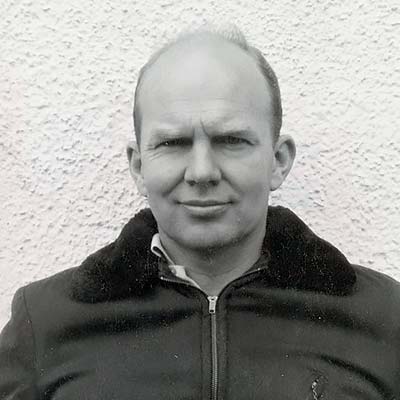
Wilmot Durgin Photograph courtesy of the Durgin family
From there he volunteered for service at Maine’s Pownal State School. Founded in 1907 for “idiotic and feeble-minded” children, Pownal had become, essentially, a warehouse for people with disabilities. What Durgin and his fifteen fellow volunteers found there shocked them: filth, stench, sickness, and pervasive loneliness and despair. Though he and his associates tried to speak up, they were fighting years of institutional inertia. For Durgin the breaking point arrived when a school “escapee” was returned to Pownal and, as public punishment, was injected with a vomit-inducing emetic by the school doctor. Durgin walked off the job in protest, knowing he would be considered AWOL and subject to criminal charges under military law. He moved in with his brother in New Jersey, and wrote to the government, explaining “exactly what I thought about the treatments in [Pownal] and also about my views on conscription. I also told them where I was living and if they wanted me they should come and get me,” he later related in a 1997 memoir.
Five months later he was arrested and sentenced to six months in prison. Did his lonely stand have any effect? We don’t know. But there are moments that demand change. Sometimes change follows from a horrifying event, but more often transformation is brought about by single acts of moral outrage, sometimes years apart, sometimes with no apparent connection to each other. How the United States moved away from state schools like Pownal to a more humane, inclusive approach to its citizens with disabilities is a story of many disparate acts like Durgin’s.
At the time of Durgin’s deployment to Maine, around 3,000 other conscientious objectors had been assigned to dozens of state schools and mental hospitals across the country. This was partly in response to the acute staffing shortage brought on by the war effort; reports of one doctor covering a thousand patients were not unusual. Many of these young men, having already acted once on conscience to oppose a war that most considered good and necessary, were uniquely sensitive to the offensive conditions that they found.
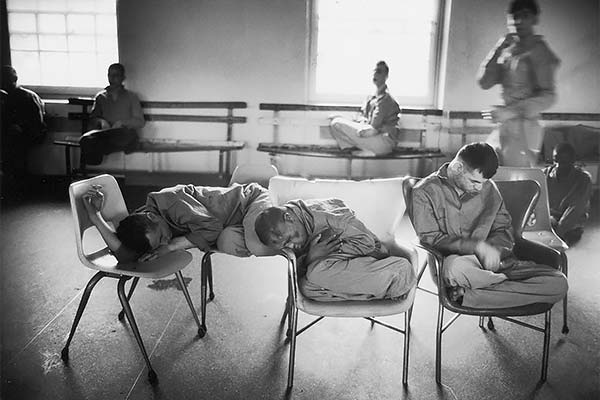
Patients sleep in chairs at Willowbrook State School in Staten Island, New York (1972). Bill Pierce/The LIFE Picture Collection/Shutterstock
They were also, as a group, better educated than the people most often hired at such institutions and better equipped to gather information and describe what they were seeing. Several organized to found the Mental Hygiene Program, later the National Mental Health Foundation, to advocate for reform. Four volunteers who had been assigned to the Philadelphia State Hospital collected accounts from fellow conscientious objectors around the country, and collaborated with the muckraking journalist Albert Maisel to publish their findings in Life magazine. In “Bedlam 1946: U.S. Mental Hospitals Are a Shame and Disgrace,” he wrote:
Beatings and murders are hardly the most significant of the indignities we have heaped upon most of the 600,000 guiltless patient-prisoners of over 180 state mental institutions. We feed thousands a starvation diet. … We jam-pack men, women, and sometimes even children into hundred-year-old firetraps in wards so crowded that the floors cannot be seen between the rickety cots, while thousands more sleep on ticks, on blankets, or on the bare floors. … Hundreds – of my own knowledge and sight – spend twenty-four hours a day in stark and filthy nakedness. … Thousands spend their days – often for weeks at a stretch – locked in devices euphemistically called “restraints”. … Hundreds are confined in “lodges” – bare bedless rooms reeking with filth and feces – by day lit only through half-inch holes through steel-plated windows, by night merely black tombs in which the cries of the insane echo unheard from the peeling plaster of the walls.
Maisel’s journalism, along with that of Albert Deutsch in PM, a New York newspaper, generated an outcry and unprecedented public scrutiny. There were other painfully graphic accounts – as early as 1943, stories arising from the efforts of CPS volunteers started coming out of Cleveland State Hospital. Van Geiger, another CPS volunteer, was so outspoken in protest against the abuses he saw at Virginia’s Eastern State Hospital that a formal investigation was launched and gained extensive and sympathetic coverage in the Richmond Times-Dispatch.
Reports from conscientious objectors assigned to Hudson River State Hospital in Poughkeepsie, New York, attracted the attention of Eleanor Roosevelt, who wrote about it in her syndicated column “My Day.” Mike Gorman, a journalist for the Daily Oklahoman, wrote a series of articles on the disgrace at the mental hospitals in his state, starting with “Misery Rules in State Shadowland.” In 1946 Mary Jane Ward published The Snake Pit, a novel drawing on her own experience as a mental patient in a New York asylum. An Oscar-nominated movie followed, starring Olivia de Havilland, with an accompanying cover story in Time. Other books appeared, among them Out of Sight, Out of Mind, by Frank L. Wright in 1947, and The Shame of the States by Deutsch in 1948.
Despite the upswell of exposure and protest, no real change came to these institutions until they collided with the story of the Kennedy family.
Rosemary Kennedy was the oldest daughter of Joseph Kennedy – patriarch, millionaire, ambassador, statesman – and his wife Rose. Born in 1918, she grew up in a family of overachievers, athletes, scholars, and competitors. But Rosemary was different. Her mother’s home nurse, reluctant to deliver the baby before the arrival of the family doctor, tried to stall the birth. The doctor was delayed for hours, overwhelmed by his patient load as the Spanish flu pandemic swept through Boston. Deprived of oxygen, Rosemary suffered brain damage.
Through her childhood and youth she appeared normal but her behavior was unpredictable and her cognitive development poor. Her father became increasingly anxious about her and what she might do. In desperation he turned to an experimental treatment that was gaining attention at the time, lobotomy, and when Rosemary was twenty-three he had her submitted to this procedure. She was never the same again.
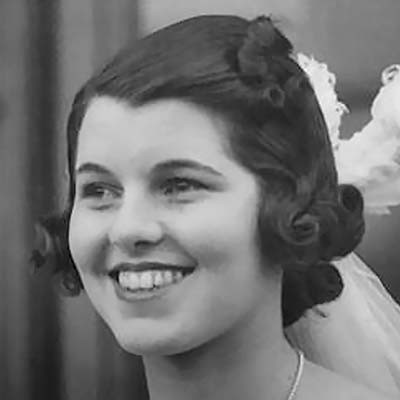
Rosemary Kennedy ready to be presented at the British Royal Court, 1938 Image from Wikimedia Commons (public domain)
“It would not take long – a few hours at the most – before the surgeons recognized that the surgery had gone horribly awry. Rosemary would emerge from the lobotomy almost completely disabled,” writes Kate Clifford Larson in Rosemary: The Hidden Kennedy Daughter (2015).
Rosemary was cared for at a comfortable private facility in Wisconsin run by the Sisters of Saint Francis of Assisi, a far cry from the state hospitals that had elicited public protest in the 1940s. Like other institutionalized, disabled people at the time, she was isolated from the outside world: her many siblings didn’t even know her whereabouts for years. But later they – especially her elder brother Jack and her sister Eunice Kennedy Shriver – found inspiration in her for both public and private activism.
While President Kennedy signed the Community Mental Health Act in 1963, Eunice and her husband, Sargent Shriver, pursued philanthropic solutions, supporting organizations devoted to research, medical care, education, and programs such as the Special Olympics. And most importantly, the family started to speak publicly about their sister and what they had learned through her.
In 1965, Robert Kennedy, then the junior senator from New York, paid a visit to the Willowbrook State School on Staten Island, at the time housing 6,200 residents in a space designed for 4,000. At the press conference that followed he called it a “snake pit,” directing renewed public attention to a tragic flaw in national help for the needs of people with disabilities.
More and more often such attention was demanded. In 1972, a young reporter named Geraldo Rivera revisited Willowbrook, breaking through the surrounding fence and filming hospital conditions. Rivera said residents were treated like “human vegetables,” calling the situation “a disgrace to all of us. This place isn’t a school, it’s a dark corner where we throw children who aren’t pretty to look at. It’s the big town’s leper colony.”
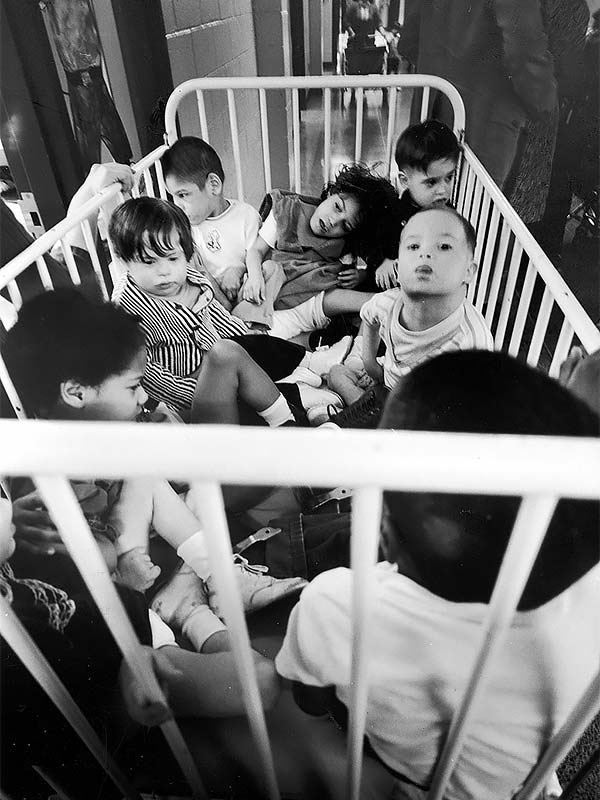
Eight children at Willowbrook State School sit crammed into a single crib while waiting to receive physical therapy (1972). Bill Pierce/The LIFE Picture Collection/Shutterstock
This proved a defining moment in the disability rights movement. There is a straight line from the Willowbrook report to the passage of the landmark Education for All Handicapped Children Act of 1975. Senator Ted Kennedy, the youngest of Rosemary’s siblings, was notable among the cosponsors and went on to become a champion in Congress for the rights of the disabled. Over the course of the next fifteen years the law’s declaration that every child, regardless of disability, is entitled to a free public education “in the least restrictive environment” helped close the warehousing institutions and inspire innovations that affected thousands of families across the country.
When they finally did shut down in the 1980s and ’90s, many of the abandoned institutions were considered haunted. At least one of them, the Pennhurst State School and Hospital, was repurposed as a haunted house, as if the property had not seen enough horror already. Located at an oxbow of the Schuylkill River in southeastern Pennsylvania, Pennhurst opened in 1903 and was plagued with stories of abuse and abysmal neglect until it finally closed in 1987 (ten years after a judge’s ruling to shut it down). Today, tourists with a fascination for the occult can pay for guided tours, haunted thrills, and even paranormal “investigations.” If nothing else, it serves as a painful reminder of how poorly we cared for our own most vulnerable citizens, and how far we have yet to go.
Rosemary’s nephew, Anthony Shriver, credited her with the most significant life of all in a family of overachievers: “The interest [Rosemary] sparked in my family towards people with special needs will one day go down as the greatest accomplishment that any Kennedy has made.”
One offshoot of the Education for All Handicapped Children Act was the creation of Rifton, the adaptive equipment company where I work as general manager. Rifton would not exist had it not been for those advocates, working often in isolation, sometimes in concert, to agitate for change. We were fortunate to be well-situated to catch the wave of reform that demanded better treatment and dignity for persons with disabilities.
Since 1953 the Bruderhof communities had been operating a children’s furniture and toy company called Community Playthings; by the 1970s there was a loyal customer base among public schools and nurseries. When Congress acted to have children moved out of institutions into the public school system, Community Playthings almost immediately started receiving urgent requests for adaptive chairs that might accommodate new students with special needs.
The Bruderhof’s Deer Spring community was in rural Norfolk, Connecticut, home to several small institutions that provided residential care for children with disabilities. Ann Storck’s Nursery, Ann’s Nursery for Babies, and the Laurel School were visited regularly by the young people of Deer Spring, who came to sing, chaperone children on outings, or play with them on the premises.
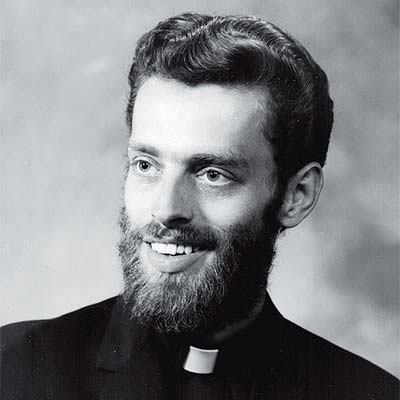
Jerry Voll Photograph courtesy of Voll family
Jerry Voll, who with his wife joined the Bruderhof in 1971, had studied to become a pastor but found himself working in the Community Playthings factory at Deer Spring, assembling wooden storage lockers, bookshelves, chairs, and similar school furnishings. He was just beginning to participate in discussions about diversifying the Bruderhof’s business enterprises when he met Kevin Purcell, an employee of Connecticut’s Department of Developmental Services who had come to Norfolk’s school system to establish a program for newly mainstreamed children with disabilities. Purcell came knocking at the Deer Spring factory and teamed up with Voll to create better seating and positioning equipment: Their first collaborative creation was the “fully adjustable” Rifton E50 Chair. Remembering those early prototypes, Voll grins wryly at the ungainly combinations of slotted plywood and plastic knobs that characterized them. Then a youth group leader, he remembers that “the high schoolers at Deer Spring never tired of teasing me about those ‘fully adjustable’ chairs.”
But they worked. Then therapy staff from Ann’s Nursery helped develop a bath chair; standing frames followed. Voll started traveling further afield, harnessing the eagerness of therapists to contribute design input. He was joined in his efforts by others at Community Playthings, not only at the Deer Spring factory but at the Woodcrest community in Rifton, New York, which specialized in aluminum fabrication, and at New Meadow Run, in Farmington, Pennsylvania, which did commercial sewing. Wilmot Durgin and Van Geiger, two of the CPS volunteers who had raised the alarm in the 1940s, had by this point joined the Bruderhof and contributed their skills to the new endeavor. Durgin was one of the first to join Voll’s efforts; his work helped create Rifton’s first prone stander prototype.
In 1977, the Community Playthings catalog included a four-page spread showcasing the new offerings. By 1980 the Rifton product line had expanded enough to justify its own catalog. Jerry Voll describes the moment when he helped the first user, a ten-year-old girl waiting with her parents in a school gym, into the newly designed Adjustable Walker. “We placed her in the walker, her first time upright and able to propel herself independently, and she took off across the gym floor. There was not a dry eye in the room.”
Since then, Rifton’s work has taken it into schools and hospitals and homes across the United States and to dozens of countries around the world. Rifton staff have had the privilege of working with people such as Linda Bidabe, who founded the MOVE Program and profoundly influenced Rifton’s product designs, and Hiroyasu Itoh, the father of the disability rights movement in Japan. In my own time at Rifton I have met countless dedicated therapists, aides, teachers, parents, siblings, and others who understand that our society is richer to the degree that we care for our vulnerable members.
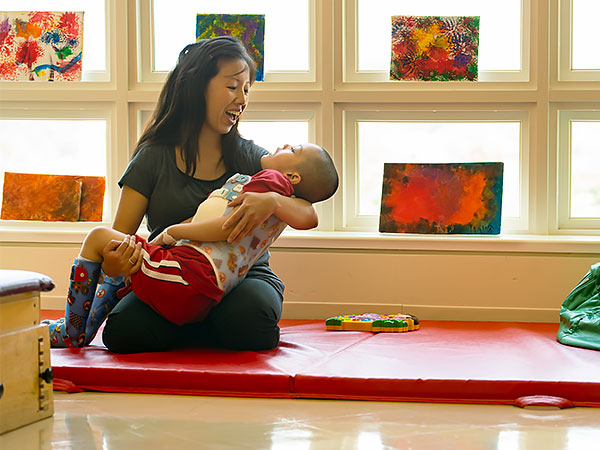
Photograph by Mark McCarty, courtesy of Rifton Equipment
Indeed, this is perhaps the single most important lesson our country could acknowledge, that providing decent care for those in greatest need is not a sacrifice, something that slows our progress; it is a path to wholeness.
What does that look like?
Well, it looks like the Center for Disability Services (CFDS), a nonprofit agency in Albany, 160 miles up the Hudson from the now-shuttered Willowbrook. Compare the footage captured by Geraldo Rivera almost fifty years ago to the video of Octavius, a young boy whose life was saved by CFDS and who receives care and attention that would have been unheard of even twenty-five years ago. That care includes world-class medical attention coupled with the strong sense, shared by the entire staff, that every child has the capacity for growth and development, in cognition and in independent movement. Everyone at the Center is involved, from the janitor to the senior therapist. They know that every moment of the day is an opportunity to learn.
The Center also designs its program to encourage active participation and respect the dignity of each child. Part of this design is using equipment that enables children to be upright and gives them agency to make their own choices and direct their own movements rather than be pushed in a wheelchair by an aide. Especially as children reach young adulthood, it also includes gear that can make it possible to use the toilet in private rather than face the indignity of being diapered in public or behind a curtain. These design choices protect individuals’ autonomy and self-respect.

Photograph by Mark McCarty, courtesy of Rifton Equipment
This approach has profound implications for the entire family of a person with special needs. Countless times I’ve heard heartbreaking stories of parents who day in and day out lift their child from a wheelchair into a car or onto a commode or into a tub, knowing that with each passing year their ability to perform these lifts is eroding. Their aging backs are no match for their children’s growth, and they wonder, “Who will do this once we can no longer?” I have seen relief flood their faces when they see what the right equipment can do for their children, teaching them to bear weight, to stand upright, to pivot in place, and often – most powerfully – to walk independently.
But one major obstacle remains for far too many families. Because of America’s patchwork healthcare and health insurance systems, getting coverage for needed medical care and equipment can be excruciatingly onerous. I hear many desperate stories of months-long struggles to get insurance companies, private or public, to approve coverage for life-changing equipment. I hear stories of insurance denials that are mindless at best, heartless at worst. I also hear about the unique terror associated with the “disability cliff,” that abrupt change in funding streams for all services that occurs, usually at age twenty-two, when a disabled adult is no longer eligible for special education under the public school system.
We drastically need a different national solution that will make services available for those without insurance coverage or sufficient private funds. So while we celebrate the progress we’ve made, we are constantly reminded there is still far to go. Closing institutional hellholes was one among many battles for the rights and dignity of the disabled. But we have hope; it comes from the small army of clinicians, technicians, and aides who work outside the public eye delivering care.
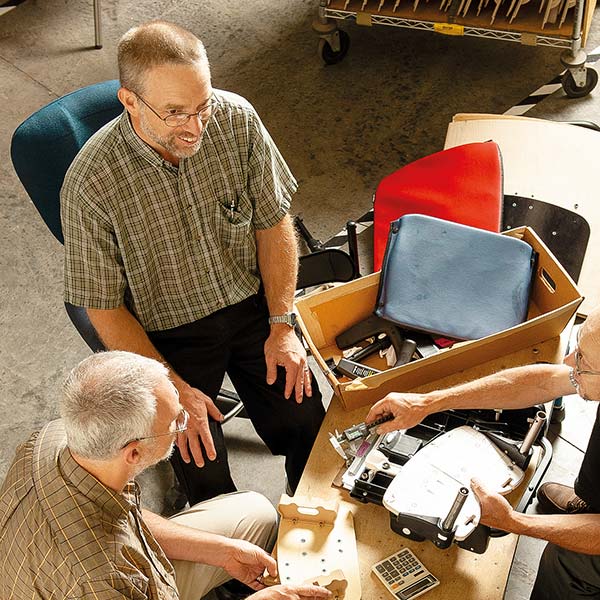
Sam Durgin, top, is the son of Wilmot Durgin and a designer at Rifton. Photograph courtesy of Rifton Equipment
When we witness situations that offend our sensibilities we can choose to turn our heads or to speak out. My own small efforts at advocacy today draw their strength and purpose from those who went before us, people like Durgin or Geiger who acted in the shadows, or like Rivera and the Kennedys who reached a national audience. Neither Durgin nor Geiger, toiling in those remote human warehouses, could have known their solitary protests would have lasting effect. But surely both would have marveled at the thread running through decades, connecting their youthful outrage to the Bruderhof, which they both joined, and to Rifton, where they helped craft equipment to improve the lives of people with disabilities.
That thread extends to the present. In a happy coincidence, I find myself today working alongside Durgin’s youngest son Sam, himself disabled from birth, who is a brilliant product designer.
Already a subscriber? Sign in
Try 3 months of unlimited access. Start your FREE TRIAL today. Cancel anytime.











































Emily Morrison
We have far to go! A larger problem is that the world doesn’t care enough. Those of us with disabilities lise family and friends. True support has to come from a broader audience. The immediate message for disability in the modern world is that most children, in utero, who might or might not have a disability, are aborted. I can’t blame a parent for choosing that, as most are told they should, and community doesn’t really come to help then, community is more likely to disappear. Tes we have come a lo g way, through the work you mentioned, and the disability crew who tried to get the ADA passed with civil rights, but that didn’t happen until Bush Senior was president. The world is obsessed with productivity, and contribution, too busy to see how people with disabilities fit into that story.